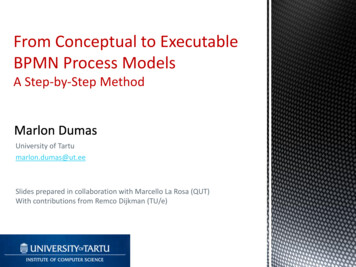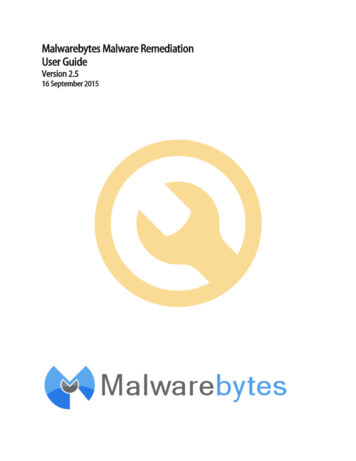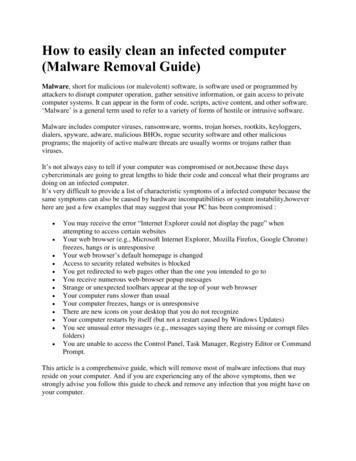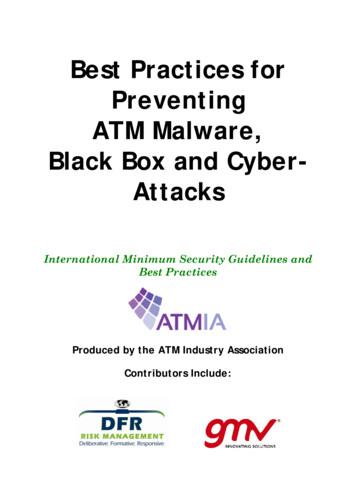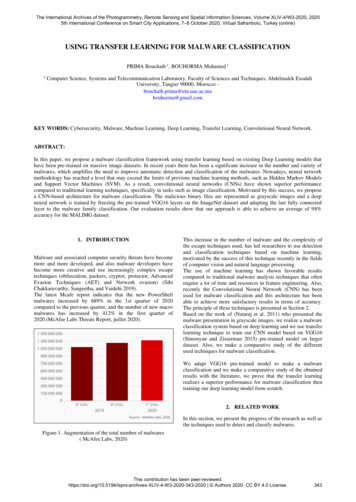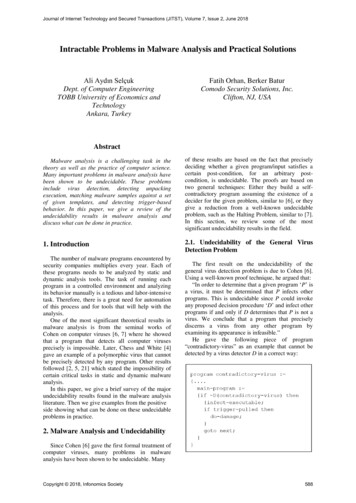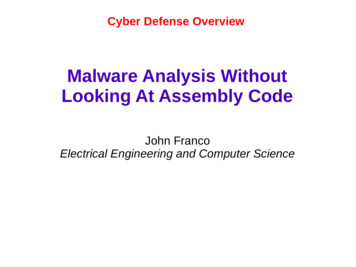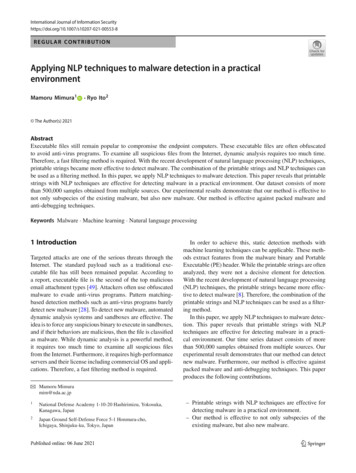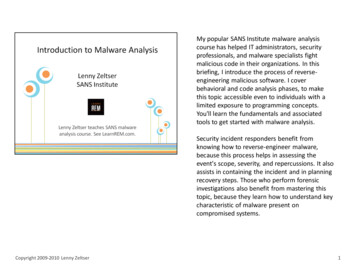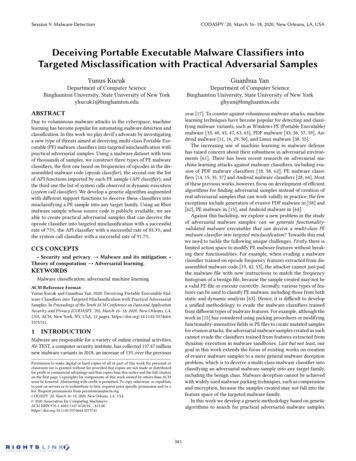
Transcription
Session 9: Malware DetectionCODASPY ’20, March 16–18, 2020, New Orleans, LA, USADeceiving Portable Executable Malware Classifiers intoTargeted Misclassification with Practical Adversarial SamplesYunus KucukGuanhua YanDepartment of Computer ScienceBinghamton University, State University of New Yorkykucuk1@binghamton.eduDepartment of Computer ScienceBinghamton University, State University of New Yorkghyan@binghamton.eduABSTRACTyear [17]. To counter against voluminous malware attacks, machinelearning techniques have become popular for detecting and classifying malware variants, such as Windows PE (Portable Executable)malware [33, 40, 45, 47, 63, 65], PDF malware [43, 56, 57, 59], Android malware [11, 16, 29, 50], and Linux malware [38, 55].The increasing use of machine learning in malware defensehas raised concern about their robustness in adversarial environments [61]. There has been recent research on adversarial machine learning attacks against malware classifiers, including evasion of PDF malware classifiers [18, 58, 62], PE malware classifiers [14, 15, 35, 37] and Android malware classifiers [28, 64]. Mostof these previous works, however, focus on development of efficientalgorithms for finding adversarial samples instead of creation ofreal adversarial samples that can work validly in practice; the fewexceptions include generation of evasive PDF malware in [58] and[62], PE malware in [15], and Android malware in [64].Against this backdrop, we explore a new problem in the studyof adversarial malware samples: can we generate functionalityvalidated malware executables that can deceive a multi-class PEmalware classifier into targeted misclassification? Towards this end,we need to tackle the following unique challenges. Firstly, there islimited action space to modify PE malware features without breaking their functionalities. For example, when evading a malwareclassifier trained on opcode frequency features extracted from disassembled malware code [19, 42, 53], the attacker cannot just padthe malware file with new instructions to match the frequencyhistogram of a benign file, because the sample created may not bea valid PE file or execute correctly. Secondly, various types of features can be used to classify PE malware, including those from bothstatic and dynamic analysis [63]. Hence, it is difficult to developa unified methodology to evade the malware classifiers trainedfrom different types of malware features. For example, although thework in [15] has considered using packing procedures or modifyingfunctionality-insensitive fields in PE files to create mutated samplesfor evasion attacks, the adversarial malware samples created as suchcannot evade the classifiers trained from features extracted fromdynamic execution in malware sandboxes. Last but not least, ourgoal in this work extends the focus of existing works on creationof evasive malware samples to a more general malware deceptionproblem, which is to deceive a multi-class malware classifier intoclassifying an adversarial malware sample into any target family,including the benign class. Malware deception cannot be achievedwith widely used malware packing techniques, such as compressionand encryption, because the samples created may not fall into thefeature space of the targeted malware family.In this work we develop a generic methodology based on geneticalgorithms to search for practical adversarial malware samples.Due to voluminous malware attacks in the cyberspace, machinelearning has become popular for automating malware detection andclassification. In this work we play devil’s advocate by investigatinga new type of threats aimed at deceiving multi-class Portable Executable (PE) malware classifiers into targeted misclassification withpractical adversarial samples. Using a malware dataset with tensof thousands of samples, we construct three types of PE malwareclassifiers, the first one based on frequencies of opcodes in the disassembled malware code (opcode classifier), the second one the listof API functions imported by each PE sample (API classifier), andthe third one the list of system calls observed in dynamic execution(system call classifier). We develop a genetic algorithm augmentedwith different support functions to deceive these classifiers intomisclassifying a PE sample into any target family. Using an Rbotmalware sample whose source code is publicly available, we areable to create practical adversarial samples that can deceive theopcode classifier into targeted misclassification with a successfulrate of 75%, the API classifier with a successful rate of 83.3%, andthe system call classifier with a successful rate of 91.7%.CCS CONCEPTS Security and privacy Malware and its mitigation; Theory of computation Adversarial learning.KEYWORDSMalware classification; adversarial machine learningACM Reference Format:Yunus Kucuk and Guanhua Yan. 2020. Deceiving Portable Executable Malware Classifiers into Targeted Misclassification with Practical AdversarialSamples. In Proceedings of the Tenth ACM Conference on Data and ApplicationSecurity and Privacy (CODASPY ’20), March 16–18, 2020, New Orleans, LA,USA. ACM, New York, NY, USA, 12 pages. ONMalware are responsible for a variety of online criminal activities.AV-TEST, a computer security institute, has collected 137.47 millionnew malware variants in 2018, an increase of 13% over the previousPermission to make digital or hard copies of all or part of this work for personal orclassroom use is granted without fee provided that copies are not made or distributedfor profit or commercial advantage and that copies bear this notice and the full citationon the first page. Copyrights for components of this work owned by others than ACMmust be honored. Abstracting with credit is permitted. To copy otherwise, or republish,to post on servers or to redistribute to lists, requires prior specific permission and/or afee. Request permissions from permissions@acm.org.CODASPY ’20, March 16–18, 2020, New Orleans, LA, USA 2020 Association for Computing Machinery.ACM ISBN 978-1-4503-7107-0/20/03. . . 15.00https://doi.org/10.1145/3374664.3375741341
Session 9: Malware DetectionCODASPY ’20, March 16–18, 2020, New Orleans, LA, USA2Our technique can deceive a variety of PE malware classifiers intotargeted misclassification with customized distance functions measuring similarity among malware samples in the feature space usedby these classifiers. Our work performs obfuscation at the sourcecode level and exploits the causality between source code modification and changes of malware features extracted from the compiledexecutables to generate adversarial samples. To ensure their practicality, our method validates their functionalities in a sandbox.In a nutshell, our main contributions are summarized as follows:RELATED WORKMachine learning-based PE malware defense. In the literature,a variety of features have been extracted from PE malware samples to train predictive machine learning models, including n-grambyte sequences in the binary executables [33, 45, 52, 63], PE headerfields [46, 54, 63], opcode n-gram sequences [19, 42, 53], WindowsAPI calls [13, 51, 65], structural features contained within control flow graphs [23, 34], and many others. In this work, we focuson creation of adversarial malware samples to deceive three specific multi-class PE malware classifiers, although in principle ourmethodology can be extended to deceive other types of malwareclassifiers. In addition to the variety of malware features used, different classification models have also been considered in theseprevious works, including SVM [33, 53, 63, 65], decision trees orensemble learning based on decision trees [42, 45, 51, 53, 63, 65],Naive Bayes [33, 42, 53, 63, 65], neural networks [42, 53]. In ourwork, we consider only random forest as the malware classifieras it has been consistently found that ensemble learning basedon decision trees tends to perform well on malware classification [33, 42, 45, 51, 53, 63, 65].Generation of adversarial malware samples. Existing efforts dedicated to creating adversarial malware samples for evadingmachine learning-based malware detection systems are summarized in Table 1. The survey tells us that although it has beensuccessful to generate real PDF malware examples that can evademachine learning-based malware detection [58, 62], efforts on adversarial attacks against PE malware classifiers focused on creationof hypothetical malware samples based on modification of featuresextracted from the malware samples. For some features, however, itmay be difficult to modify their values while preserving malware’sfunctionability. The rare exceptions include adversarial machinelearning attacks against binary malware classifiers trained on staticanalysis features [15] and API call features from dynamic execution [48]. Different from our work, they do not attack a multi-classmalware classifier and are able to evade neither the opcode classifiernor the system call classifier considered in this study.Algorithms for searching adversarial samples. Many algorithms have been proposed to generate adversarial samples fordeep learning prediction models. These methods include Fast Gradient Sign Method (FGSM) [27], the Jacobian-based Saliency Mapapproach (JBSM) [44], DeepFool [41], the Carlini & Wagner’s attack [22], ElasticNet attacks [24], and momentum-based iterativealgorithms [26]. Among the previous works aimed at generatingadversarial malware samples, the algorithms used to find adversarial examples include genetic algorithms [62], reinforcement learning [15], FGSM [35, 37], generative adversarial networks [30], gradient descent algorithms [32], JBSM [28], and Carlini & Wagner’sattack [37]. As this work uses random forest as the malware classifier, those methods developed for generating adversarial samplesfor deep learning models are not directly applicable. We use a malware dataset with tens of thousands of PE samples to train three multi-class classifiers, the first one basedon frequencies of opcodes in the disassembled malware code(opcode classifier), the second one the list of API functionsimported by each PE sample (API classifier), and the thirdone the list of system calls observed in dynamic execution(system call classifier) to classify a PE sample into its corresponding family. Based on bogus control flow obfuscation, we study the effects on the opcode feature values due to basic block cloningthrough differential analysis. To create an adversarial samplethat can deceive the opcode classifier into targeted misclassification, we formulate an optimization problem that minimizes the Kullback-Leibler divergence between the opcodefrequency feature vectors from the target. We develop a genetic algorithm to search practical malware variants that candeceive the opcode classifier into targeted misclassification. To deceive the API classifier, we use a popular API obfuscation technique to conceal imported API functions. Weformulate an optimization problem that minimizes the Euclidean distance between the imported API function featurevectors from the target. We adopt a similar genetic algorithmto produce malware variants whose API feature vectors aregradually converging towards the point with a minimal Euclidean distance from the target sample in the feature space. As the system call classifier is trained from malware features extracted from dynamic execution, we consider addingdummy API calls on malware’s execution paths to influencethe list of system calls invoked. We carefully select API callsto be added to the original malware sample with predictableeffects on the feature vectors. A similar genetic algorithm isused to search adversarial samples based on a fitness function that uses the Jensen-Shannon divergence to measurethe distance of system call frequency feature vectors. The experiments reveal that our methods can mutate theRbot sample, whose source code has been publicly available,into a functionable variant misclassified by the opcode classifier into any target family with a successful rate of 75%, bythe API classifier with a successful rate of 83.3%, and by thesystem call classifier with a successful rate of 91.7%.The remainder of this work is organized as follows. Section 2presents related work. Section 3 introduces the problem formulation.Section 4 presents the malware dataset and the three malwareclassifiers considered in this work. In Sections 5, 6 and 7, we presentthe algorithms for deceiving these three classifiers into targetedmisclassification, respectively. We discuss the scope of this work inSection 8 and draw concluding remarks in Section 9.3PROBLEM FORMULATIONConsider a PE malware classifier Cmal , which classifies PE samplesinto disjoint families F { fi }1 i F . Without loss of generality, allbenign samples are assumed to belong to the same family fbeniдn F . To perform threat analysis of adversarial samples on classifier342
Session 9: Malware DetectionCODASPY ’20, March 16–18, 2020, New Orleans, LA, USATable 1: Existing works on creation of adversarial malware samples for deceiving malware classifiers. Being Validated meansthat the functionability of an adversarial sample created has been validated through dynamic analysis.ArticleBiggio et al. [18]Srndic and Laskov [58]Xu et al. [62]Grosse et al. [28]Demontis et al. [25]Yang et al. [64]Liu et al. [37]Kolosnjaji et al. [32]Kreuk et al. [35]Hu and Tan [30]Al-Dujaili et al. [14]Anderson et al. [15]Rosenberg et al. [48]Abusnaina et al. [12]Our workMalware TypePDF malwarePDF malwarePDF malwareAndroid malwareAndroid malwareAndroid malwarePE malwareUnknownPE malwareUnknownPE malwarePE malwarePE malwareLinux malwarePE malwareValidated? Binary or sMulti-classCmal , we play devil’s advocate by obfuscating an existing PE samplePEo . The true family of sample PEo is assumed to be fo F .Our goal is to transform PEo into a new sample PEo′ such thatclassifier Cmal misclassifies PEo′ as a target family fd where fd , fo .The purpose of targeted misclassification can be:Targeted sYesYesYesYes Malware classifier as a blackbox: When creating adversarialsamples, we assume that the attacker does not know any internal detail about malware classifier Cmal , such as its modelparameters, except the type of features it uses for malwareclassification. The attacker treats Cmal as a blackbox, whichreturns the classification result with an input PE sample. Anchor samples from the target family: We assume that theattacker has access to a set of PE samples from the targetfamily fd , or equivalently their features with which Cmalwould classify the samples as the target family fd . We useAfd to denote the set of anchor samples for target family fd . Malware evasion: The author of malware sample PEo maywant to obfuscate it so classifier Cmal would misclassifyit as benign (i.e., fd fbeniдn ), regardless of its originalfamily fo . This can effectively evade the detection of Cmalfor malicious PE programs. As demonstrated in Table 1, themajority of existing works on adversarial malware samplesfocuses on malware evasion. Malware deception: In addition to malware evasion whichrequires fd fbeniдn , an attacker may also want to achievefd , fbeniдn . In these cases, the attacker would like to createPE samples that can deceive malware classifier Cmal intobelieving that they are from a specific family. For instance,if the attacker can morph a benign PE file into a sample thatis misclassified by Cmal as a Stuxnet attack [8], it may causepanic to the institutions who deploy malware classifier Cmalor mislead their threat mitigation operations.Regarding the third assumption, one may wonder why the attacker would bother to create new adversarial samples pretendingto belong to the target family if he already has real examples fromit. There could be multiple reasons for this. Firstly, in practice theremay be multiple defense schemes deployed against malware attacks. If the signatures of these real samples from the target familyhave already been known, they may be detectable by up-to-date AV(Anti-Virus) scanners. Secondly, depending on the attacker’s intention, directly using the real samples from the target family may notachieve his deception goal. For example, the attacker may just wantto use a benign PE sample pretending to be a Stuxnet malware forpurpose of intimidation without causing any real harm.In this work we consider the malware deception problem, whichis a generalization of the malware evasion problem because noconstraint is imposed on the target family fd .Adversary model. In this work, we make the following assumptions about the adversary:4MALWARE DATASET AND CLASSIFIERSIn this section we describe the PE malware dataset we use in thisstudy, three types of malware classifiers trained on this dataset, andfinally the source code of an Rbot sample used to deceive the threeclassifiers into targeted misclassification. Availability of source code: Different from existing works thatdirectly modify malware samples (e.g., malicious PDF files)or their features to evade detection, we instead assume thatthe source code of the malware sample should be available.The availability of source code enlarges the action spaceof the attacker for deceiving malware classifier Cmal intotargeted misclassification.PE malware dataset. Albeit it is easy to download a large number of malware samples from public repositories (e.g., VirusShare [9]),it is not easy to find many labeled ones. We use a PE malware datasetthat contains 15,721 unpacked and 9,479 packed PE malware samples belonging to 12 malware families, Bagle, Bifrose, Hupigon, Koobface, Ldpinch, Lmir, Rbot, Sdbot, Swizzor, Vundo, Zbot, and Zlob. Our343
Session 9: Malware DetectionCODASPY ’20, March 16–18, 2020, New Orleans, LA, USAUnpackedPackedF-measure by familyNumber of samples100008000600040002000BenigBa nglBi efrH oseupKo igoob nLd facpi encLm hirRboSd tbSw otizzVu orndZb ootZlobDistribution per family1.00.90.80.70.60.50.40.30.20.10.00Malware familyopcode:1-gramapi:booleansystem callon ace ch mir Rbot dbot izzor undo Zbot Zlobign gle oseS Sw VBen Ba Bifr HupigKoobf Ldpin LMalware familyFigure 1: Distribution of family sizes inthe malware datasetFigure 2: Classification performance ofthe three malware classifiersFigure 3: Illustration of bogus flow control obfuscationmalware dataset has more samples than that used in Kaggle’s Microsoft malware classification competition, which consists of 10,868labeled malware samples belonging to nine families [5]. Moreover,the Microsoft malware dataset is unsuitable for this study, as wecannot find source code for any of its nine families. In addition toour malware dataset, we use 519 Benign PE samples and as mentioned earlier, all these benign samples are treated as belonging to aspecial Benign family. The size distribution of these 13 malware families is given in Figure 1. The malware dataset is imbalanced acrossdifferent malware families, which is consistent with the previousobservations [49, 53, 63].The instructions disassembled from a PE program can be represented as a control flow graph (CFG), where each node characterizes a basic block without instructions branching out except at itsexit and each edge a control flow transition between basic blocksthrough jump instructions. In our implementation, we use the popular IDA Pro tool to reconstruct the CFG of each PE program but ourmethodology can be generalized to any CFG recovery technique.(b) (b) (b)Given the CFG Gp (Vp , Ep ) constructed from program p, wePE malware classifiers. We extract three types of malwarefeatures, each used to train a random forest classifier. We choose therandom forest classification model because previous reports haveconsistently shown that ensemble learning based on decision treesperform well on the three types of malware features consideredin this study [33, 42, 45, 51, 53, 63, 65]. The following discussionelaborates on how we build these three malware classifiers.(1) Opcode classifier Cmal (O (n) ): random forest classifier trainedon opcode features. Malware classifiers trained with opcode n-gramfeatures have been investigated in a plethora of previous works [19,42, 53]. To obtain opcode n-gram features, we disassemble the binary executable program of each unpacked malware in our datasetinto instructions in an assembly language. Packed malware samples usually have malware instruction code obfuscated and are thusignored in training Cmal (O (n) ). An assembly instruction includesboth its opcode and operands. For example, using the IDA Protool [4], we can obtain the first nine instructions at the entry pointof a Zbot malware sample:v Vp , be αv (x). It is noted that superscript (b) is intentionallyadded to distinguish the binary executable of program p from itsother representations, which we shall see later. The count value ofopcode n-gram feature x in program p, where x O (n) , is:Õβp (x) αv (x)(1)i1: push ebpi4: push ebxi7: call sub 41C53Bi2: mov ebp, espi5: xor ecx, ecxi8: test al, alobtain its opcode n-gram feature vector as follows. We use O (n) todenote the entire set of opcode n-gram features. For each opcode(b)n-gram feature x O (n) , let its count in a basic block of Gp ,(b)(b)v VpThe frequency value of opcode n-gram feature x in program p isÍobtained by normalizing βp (x n ) with x n O n βp (x n ). As discussedearlier, the frequency values of opcode n-gram features are used totrain a malware classifier. We use Cmal (O (n) ) to denote the specificmalware classifier trained with opcode n-gram features in O (n) .(2) API classifier Cmal (A): random forest classifier trained on imported API function features. Another type of malware featureswidely used for PE malware classification is the imported WindowsAPI functions, which can be discovered from the Import DirectoryTable in the .idata section by following the second data directoryof the image optional header inside the PE file header.We use IDA Pro [4] to extract Windows API functions importedby unpacked PE samples in our dataset. Packed samples are ignoredbecause their imported API functions may be obfuscated. The unionof all imported Windows API functions is used to create the APIfunction feature vector, where the feature value of a Windows APIfunction is 1 if imported by the sample, or 0 otherwise. We traina multi-class random forest classifier based on the API functionfeatures. We use Cmal (A) to denote this malware classifier.(3) System call classifier Cmal (S): random forest classifier trainedon system call features. System calls have been used for malware detection and classification in a number of previous works [20, 21, 38].i3: sub esp, 10hi6: xor b1, b1i9: jz loc 41D55CThe opcode in each instruction is shown in italics in the abovetable. The opcode n-gram feature uses the combination of n consecutive opcodes within a sliding window as its feature name andits frequency as its feature value. In the example, there are seven1-gram features with its feature values shown in the parentheses:push (2/9), mov (1/9), sub (1/9), xor (2/9), call (1/9), test (1/9), and jz(1/9); there are eight 2-gram features, each with a value of 1/8.344
Session 9: Malware DetectionCODASPY ’20, March 16–18, 2020, New Orleans, LA, USAWe use the Intel Pin tool [6] to dynamically instrument each malware sample in our dataset, either packed or unpacked, and monitorthe sequence of system calls executed in a Windows 7 malwaresandbox with Internet connections emulated by FakeNet [3]. Wefind that 4255 unpacked samples cannot be dynamically instrumented by Intel Pin and are thus ignored in our experiments. Forall the malware sample dynamically instrumented by Intel Pin, weobserve 463 unique system calls. They are used to construct eachsample’s feature vector, whose values indicate the frequency ofeach system call made by the malware. Using these system callfeatures, we train a multi-class random forest classifier to classify aPE sample to its corresponding family. We use Cmal (S) to denotethis malware classifier.Classification performance. We use 5-fold cross validation onour malware dataset to evaluate the classification performancesof the malware classifiers. For each malware family, we treat theclassification results as from a binary classifier: either belonging tothe family or not. Precision P is defined as Tp /(Tp Fp ), where Tpand Fp are the numbers of true positive and false positive samples inthe results, respectively. Similarly, recall R is defined as Tp /(Tp Fn ),where Tp and Fn are the numbers of true positive and false negativesamples in the results, respectively. The F-measure (or F-1 score) ofthe binary classifier is the harmonic mean of precision and recall,2PR/(P R).The classification performance results for each family by thethree malware classifiers, Cmal (O (1) ), Cmal (A) and Cmal (S (1) ) areshown in Figure 2. Over all the 13 families, the mean F-measuresfor these three malware classifiers are 0.893, 0.878, and 0.924, respectively.Rbot source code compilation. In our work, we do not wantto use the source code of a benign program because it does not allowus to evaluate the effectiveness of our method in malware evasion.To deceive a malware classifier into targeted misclassification, wealso prefer working on a malware sample that belongs to one ofthe output families of that classifier. We add this sample to thetraining dataset so that the classifier can correctly classifies it intothe correct family. The reason behind this extra step is to ensurethat if a new variant transformed from this sample is classified intothe target family, it should not be done by a mistake of the classifier.Due to these concerns, we use the source code of an Rbot samplepublicly available in the malware zoo on github [7]. To producefunctionable PE malware samples from the Rbot source code, wehave used two different compilation methods:Compilation with MSVC : We have compiled the Rbot sourcecode with the MSVC (Microsoft Visual C ) 6.0 compiler ( MSC VER 1200, Visual Studio 6.0). During this process we overcame Windows version-specific challenges such as installing required runtime libraries in the system directories and installing MicrosoftSDK (Software Development Kit) in the case that existing librariesare not compatible with the compiler, and configuring the correctlibrary paths and system paths. The size of the Rbot malware sample compiled with MSVC is 222KB in a Windows 7 VM (VirtualMachine).Compilation with clang . A practical PE sample compiled withclang should be able to use Windows runtime libraries, which requires Visual C ABI (Application Binary Interface) compatibility.345We have compiled the Rbot source code with clang version 3.4in a Windows VM and produced the PE sample with the MSVC 6.0 linker. As the Visual C ABI changes over time, linking theclang-produced object files with the MSVC linker may incurcompatibility issues. We overcame these challenges by providingthe clang compiler with multiple flags, including -fms-compatibility,-fms-extensions, -fdelayed-template-parsing, and -fmsc-version 1200(which indicates the Microsoft compiler version to be MSVC 6.0).Successful compilation with clang also calls for slight modification of the source code, such as replacing use of the new operatorwith a call of the malloc function and redeclaring variables outsidethe for loops. The size of the Rbot malware sample compiled withclang is 265KB in a Windows 7 VM.Malware deception goal. Our goal is to obfuscate the Rbotmalware at the source code level so that the malware executablecompiled with either MSVC or clang satisfies the followingtwo criteria. First, the adversarial malware sample should deceiveone of the three aforementioned classifiers into classifying it toa targeted family. It is noted that our goal is to deceive machinelearning-based malware classifiers into targeted misclassification.The popular VirusTotal service [10] relies on tens of AV (AntiVirus) scanners for malware detection. These AV scanners usuallyuse signature-based detection and the detection results may notinclude the correct family labels of the malware samples. Thereforeour experiments do not use the detection results of the VirusTotalservice for performance evaluation.The second criterion requires the adversarial malware examplecreated to be functionable. We validate the functionability of anRbot malware sample as follows. We set up a C&C server and configure each Rbot malware sample to communicate with the serverafter it infects a VM running Windows 7. To automate the wholeprocess, we use the Cuckoo tool [2]. The communication betweenthe bot and the server is done through an mIRC channel, whichthe botmaster uses to control the bot-infected machine throughvarious commands. In our implementation, we emulate six differentcommands from the botmaster, which are summarized in Table 2.If the bot machine’s responses to these commands are the same asexpected, the malware sample is deemed as functionable.5DECEIVING OPCODE CLASSIFIERO .This section describes how to deceive classifier Cmal(1)5.1MethodologyBogus control flow. The building block of our method is boguscontrol flow that adds fake basic blocks to an existing CFG. Our implementation is based on bogus control flow in llvm-obfuscator [31]illustrated in Figure 3. The bogus flow obfuscation is performed ona basic block, OriдinalBB, in the CFG represented at the LLVM IRlevel. The last instruction of OriдinalBB is T erminatorO BB indicating the exit of this basic block. The transformation introduces twoalways-true conditions, Condition 1 and Condition 2 , which can beany opaque predicates used for malware obfuscation. Condition 1 isa
static and dynamic analysis [63]. Hence, it is difficult to develop a unified methodology to evade the malware classifiers trained from different types of malware features. For example, although the . algorithms to search for practic
